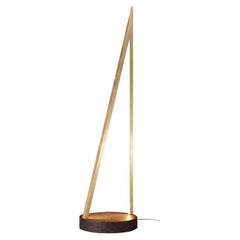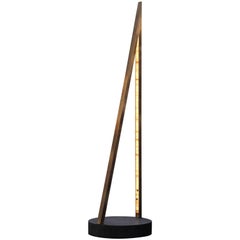Archimedes Floor Lamp By Christopher Boots
21st Century and Contemporary Australian Modern Floor Lamps
Concrete, Brass
Recent Sales
21st Century and Contemporary Australian Modern Floor Lamps
Quartz, Brass
People Also Browsed
2010s Portuguese Modern Screens and Room Dividers
Oak
21st Century and Contemporary Mexican Mid-Century Modern Table Lamps
Wood, Fabric, Linen, Fiberglass
2010s Australian Wall Lights and Sconces
Stone, Onyx, Aluminum, Brass
20th Century Spanish Gothic Revival Gueridon
Iron, Gold Leaf, Wrought Iron
2010s Australian Wall Lights and Sconces
Quartz, Brass
2010s French Modern Chairs
Oak, Fabric, Bouclé
2010s Brazilian Post-Modern Chairs
Leather, Textile, Upholstery, Faux Leather, Cane, Hardwood, Walnut
21st Century and Contemporary Portuguese Dining Room Tables
Marble, Brass
21st Century and Contemporary Australian Modern Wall Lights and Sconces
Crystal, Quartz, Brass
21st Century and Contemporary American Aesthetic Movement Chandeliers an...
Glass
21st Century and Contemporary Australian Modern Chandeliers and Pendants
Crystal, Quartz, Brass
21st Century and Contemporary Modern Chandeliers and Pendants
Aluminum
Vintage 1950s Swedish Scandinavian Modern Wall Lights and Sconces
Brass
20th Century Italian Mid-Century Modern Decorative Bowls
Brass
Christopher Boots for sale on 1stDibs
Christopher Boots is an Australian lighting designer whose love of natural materials shines through in all of his creations. Boots’s contemporary lighting fixtures are made from brass and quartz crystals, giving them an ethereal glow. His designs include spectacular chandeliers and pendant lights, geometric wall lights and sculptural table lamps.
Boots was born in 1979 in Melbourne, Australia. He initially studied linguistics and literature before graduating from the National School of Design in 2005 with a bachelor’s degree in industrial design. He apprenticed with pioneering lighting designer Geoffrey Mance and spent several years training in various lighting techniques before developing his unique style.
In 2011, Boots opened the Christopher Boots lighting studio and released his first collection. The studio was founded on the idea of material and metaphysical exploration, combining geometry, symmetry, pattern and symbology. Every piece is made by hand, using both traditional techniques and cutting-edge technology. Boots works with sculptors, ceramicists, glass blowers, coppersmiths and bronze casters to create luminous fixtures.
“I am influenced by nature primarily,” Boots told The Study, “the way nature works and evolves through mathematics, biology and time.” Taking inspiration from nature, many of Boots’s lighting fixtures are modeled after the forms of stalactite, which he describes as “beautiful yet completely haunting.”
Boots’s lighting designs have been showcased at the National Gallery of Victoria, Parliament House in Melbourne, Rossana Orlandi, Hermès in Melbourne and Cassina in Japan.
On 1stDibs, find an extensive collection of Christopher Boots lighting.
A Close Look at Modern Furniture
The late 19th and early 20th centuries saw sweeping social change and major scientific advances — both of which contributed to a new aesthetic: modernism. Rejecting the rigidity of Victorian artistic conventions, modernists sought a new means of expression. References to the natural world and ornate classical embellishments gave way to the sleek simplicity of the Machine Age. Architect Philip Johnson characterized the hallmarks of modernism as “machine-like simplicity, smoothness or surface [and] avoidance of ornament.”
Early practitioners of modernist design include the De Stijl (“The Style”) group, founded in the Netherlands in 1917, and the Bauhaus School, founded two years later in Germany.
Followers of both groups produced sleek, spare designs — many of which became icons of daily life in the 20th century. The modernists rejected both natural and historical references and relied primarily on industrial materials such as metal, glass, plywood, and, later, plastics. While Bauhaus principals Marcel Breuer and Ludwig Mies van der Rohe created furniture from mass-produced, chrome-plated steel, American visionaries like Charles and Ray Eames worked in materials as novel as molded plywood and fiberglass. Today, Breuer’s Wassily chair, Mies van der Rohe’s Barcelona chair — crafted with his romantic partner, designer Lilly Reich — and the Eames lounge chair are emblems of progressive design and vintage originals are prized cornerstones of collections.
It’s difficult to overstate the influence that modernism continues to wield over designers and architects — and equally difficult to overstate how revolutionary it was when it first appeared a century ago. But because modernist furniture designs are so simple, they can blend in seamlessly with just about any type of décor. Don’t overlook them.
Materials: Brass Furniture
Whether burnished or lacquered, antique, new and vintage brass furniture can elevate a room.
From traditional spaces that use brass as an accent — by way of brass dining chairs or brass pendant lights — to contemporary rooms that embrace bold brass decor, there are many ways to incorporate the golden-hued metal.
“I find mixed metals to be a very updated approach, as opposed to the old days, when it was all shiny brass of dulled-out silver tones,” says interior designer Drew McGukin. “I especially love working with brass and blackened steel for added warmth and tonality. To me, aged brass is complementary across many design styles and can trend contemporary or traditional when pushed either way.”
He proves his point in a San Francisco entryway, where a Lindsey Adelman light fixture hangs above a limited-edition table and stools by Kelly Wearstler — also an enthusiast of juxtapositions — all providing bronze accents. The walls were hand-painted by artist Caroline Lizarraga and the ombré stair runner is by DMc.
West Coast designer Catherine Kwong chose a sleek brass and lacquered-parchment credenza by Scala Luxury to fit this San Francisco apartment. “The design of this sideboard is reminiscent of work by French modernist Jean Prouvé. The brass font imbues the space with warmth and the round ‘portholes’ provide an arresting geometric element.”
Find antique, new and vintage brass tables, case pieces and other furnishings now on 1stDibs.
Finding the Right Floor-lamps for You
The modern floor lamp is an evolution of torchères — tall floor candelabras that originated in France as a revolutionary development in lighting homes toward the end of the 17th century. Owing to the advent of electricity and the introduction of new materials as a part of lighting design, floor lamps have taken on new forms and configurations over the years.
In the early 1920s, Art Deco lighting artisans worked with dark woods and modern metals, introducing unique designs that still inspire the look of modern floor lamps developed by contemporary firms such as Luxxu.
Popular mid-century floor lamps include everything from the enchanting fixtures by the Italian lighting artisans at Stilnovo to the distinctly functional Grasshopper floor lamp created by Scandinavian design pioneer Greta Magnusson-Grossman to the Paracarro floor lamp by the Venetian master glass workers at Mazzega. Among the more celebrated names in mid-century lighting design are Milanese innovators Achille and Pier Giacomo Castiglioni, who, along with their eldest brother, Livio, worked for their own firm as architects and designers. While Livio departed the practice in 1952, Achille and Pier Giacomo would go on to design the Arco floor lamp, the Toio floor lamp and more for legendary lighting brands such as FLOS.
Today’s upscale interiors frequently integrate the otherworldly custom lighting solutions created by a wealth of contemporary firms and designers such as Spain’s Masquespacio, whose Wink floor lamps integrate gold as well as fabric fringes.
Visual artists and industrial designers have a penchant for floor lamps, possibly because they’re so often a clever marriage of design and the functions of lighting. A good floor lamp can change the mood of any room while adding a touch of elegance to your entire space. Find yours now on 1stDibs.

